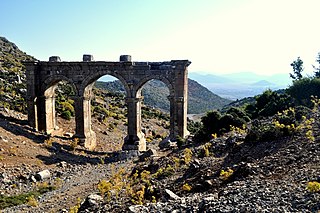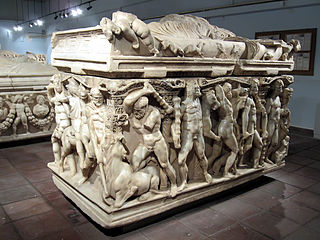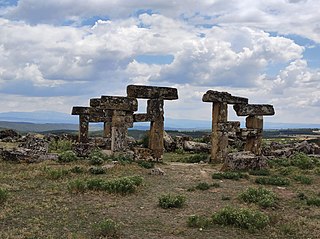This article includes a list of references, related reading, or external links, but its sources remain unclear because it lacks inline citations .(September 2017) |
Sion is an ancient city in the Roman province of Asia Prima, in Asia Minor.
This article includes a list of references, related reading, or external links, but its sources remain unclear because it lacks inline citations .(September 2017) |
Sion is an ancient city in the Roman province of Asia Prima, in Asia Minor.
Sion was a bishopric, suffragan of the Metropolitan of the provincial capital Ephesus. It nominally restored as a Roman Catholic titular bishopric and promoted to titular archbishopric in 1950.
Sion may refer to
Apamea or Apameia is the name of several Hellenistic cities in western Asia, after Apama, the Sogdian wife of Seleucus I Nicator, several of which are also former bishoprics and Catholic titular see.

Ariassus or Ariassos was a town in Pisidia, Asia Minor built on a steep hillside about 50 kilometres inland from Attaleia.
Berissa, also spelled Berisa, Verisa, or Verissa, was a city in the late Roman province of Pontus Polemoniacus, in Asia Minor, which Kiepert and W. M. Ramsay have identified with the modern village of Baulus, 25 kilometres south-west of Tokat.
Harpasa was a city and bishopric in ancient Caria in Roman Asia Minor, which only remains a Latin Catholic titular see.
Motella, Metello(u)polis, or Pulcherianopolis was a city in the Roman province of Phrygia Pacatiana, in Asia Minor, probably on the site of the modern Yeşiloba (Medele).

Tiberiopolis was a town in the Roman province of Phrygia Pacatiana, mentioned by Ptolemy, Socrates of Constantinople and Hierocles. At various times, it was considered as part of Phrygia, Isauria, and the late Roman province of Pisidia.
Caloe was a town in the Roman province of Asia. It is mentioned as Kaloe or Keloue in 3rd-century inscriptions; as Kalose in Hierocles's Synecdemos (660); and as Kalloe, Kaloe, and Kolone in Parthey's Notitiæ episcopatuum, in which it figures from the 6th to the 12fth or 13th century.
Mastaura was a town in ancient Lycia.
Isba was a city on the border of ancient Pamphylia. It has been identified with the modern village of Çeşme.

Blaundus was a Greek city founded during the Hellenistic period in Asia Minor, presently Anatolia, and is now a Latin Catholic titular bishopric.
Daldis, was a town on the borders of ancient Lydia and Phrygia, a former bishopric, and is now a Latin Catholic titular see. It also minted coins in antiquity with the legend Δαλδιανων. It also bore the name Flaviocaesaria or Phlabiokaisareia, which is not attested among ancient authors but is reconstructed from epigraphic and other evidence.
Palaeopolis in Pamphylia was an Ancient city and bishopric in Asia Minor, and is a Catholic episcopal titular see.
Dionysiopolis or Dionysopolis, was a city of Phrygia in Asia Minor. The demonym Dionysopolitae (Διονυσοπολίτης) occurs on coins, and in a letter of M. Cicero to his brother Quintus, in which he speaks of the people of Dionysopolis being very hostile to Quintus, which must have been for something that Quintus did during his praetorship of Asia. Pliny places the Dionysopolitae in the conventus of Apamea, which is all the ancient writers note of their position. We may infer from the coin that the place was on the Maeander, or near it. Stephanus of Byzantium says that it was founded by Attalus and Eumenes. Stephanus mentions another Dionysopolis in Pontus, originally called Cruni, and he quotes two verses of Scymnus about it; however, the town of Dionysupolis in Thrace but on the Pontus, rather than in Pontus could be meant.
Colonia or Koloneia, also called Colonia in Armenia to distinguish it from other towns of the same name, was a town of ancient Lesser Armenia, inhabited during Hellenistic, Roman, and Byzantine times. It became important enough to be the seat of a bishop, a suffragan in the Late Roman Province of Armenia Prima, but faded like most in Asia Minor. No longer a residential bishopric, it remains, under the name Colonia in Armenia, a titular see of the Roman Catholic Church.
Briula or Brioula was an ancient city and bishopric of ancient Lydia or of Caria in Asia Minor, which remains a Latin Catholic titular see.
Anineta, also known as Aninetum or Anineton, was a town of ancient Lydia or of Caria, and later of the Roman, and Byzantine empires, located in modern Turkey, the site of an ancient bishopric in and was an important site early in christianity. Anineta remains today a titular see of the Roman Catholic Church in the ecclesiastical province of Ephesus. In addition it minted coins bearing the legend Ἀνινησίων.
Apollonos Hieron was an ancient city of Lydia.
Limnae (in Pisidia) was a city and bishopric in the Roman province of Pisidia (Asia Minor), which is now a Latin Catholic titular see.
Ottaviano Maria Sforza (1475–1545) was a Roman Catholic prelate who served as Bishop of Arezzo (1519–1525), Bishop of Lodi, and Titular Patriarch of Alexandria (1541–1545) and Bishop of Terracina, Priverno e Sezze (1541–1545).